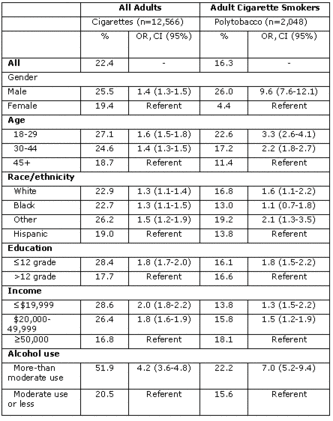Much tobacco research and public health reporting has focused on cigarettes, but seven billion dollars worth of cigars, pipes, and smokeless tobacco are sold in the United States each year (U.S.D.A.). The few studies of polytobacco use (i.e., cigarette use in combination with other tobacco products) suggest that such use can lead to increased risk of tobacco-related diseases and nicotine addiction (Gilpin & Pierce, 2003; Wetter et al., 2002). This week’s ASHES reviews a study which explores the prevalence and characteristics of polytobacco users across the United States.
Bombard, Pederson, Nelson, and Malarcher (2007) analyzed the Behavioral Risk Factor Surveillance System (BRFSS) data from the ten states (i.e., Arkansas, Colorado, Delaware, Indiana, Nebraska, New Jersey, North Carolina, North Dakota, Texas, and Wyoming) whose surveys incorporated a module focusing on the consumption of tobacco products. The random-digit-dialed telephone survey included items about whether participants (n=56,099) ever smoked cigarettes (i.e., smoked 100 or more cigarettes), used cigars, smokeless tobacco, pipes, and bidis, and currently smoked cigarettes and used cigars, smokeless tobacco, pipes, and bidis.
Results indicated that 22.4% of adults currently used cigarettes (i.e., using every day or most days) but only 3.4% of adults were polytobacco users. The Figure shows that the predictive value of many characteristics included in the multivariate analysis is weak. However, gender, education level, and “more-than-moderate” alcohol use predicted both cigarette and polytobacco use. Men reported a slightly higher likelihood of smoking cigarettes than women and were 9.6 times more likely than women to be polytobacco users. Respondents with less than a high school education were equally likely to be cigarette smokers as polytobacco users; respondents who reported “more-than-moderate” alcohol use were more likely to be cigarette smokers and significantly more likely to be polytobacco users.

Figure. Prevalence and characteristics associated with cigarette use among adults and current polytobacco use among adult smokers (adapted from Bombard et al., 2007). Click image to enlarge.
This study is limited to respondents from the ten states that included a tobacco product module within their BRFSS surveys; findings from the study might not generalize well to populations in other states. Also, responses were self-report, possibly underestimating or biasing the prevalence of tobacco use.
This study is one of the first to examine the prevalence of, and characteristics associated with, polytobacco use; the findings provide significant insight into tobacco use beyond cigarettes. Although these results indicate a low prevalence of polytobacco use, especially among women, clinicians and scientists should not overlook this phenomenon. More information is needed about the escalated risk profile associated with polytobacco use. Hopefully, a better understanding of the extent of polytobacco use and the population of polytobacco users will stimulate enhanced intervention and prevention programs.
–Sara Kaplan.
References
Bombard, J. M., Pederson, L. L., Nelson, D. E., & Malarcher, A. M. (2007). Are smokers only using cigarettes? Exploring current polytobacco use among an adult population. Addictive Behaviors, 32, 2411-2419.
Gilpin, E. A., & Pierce, J. P. (2003). Concurrent use of tobacco products by California adolescents. Preventive Medicine, 36, 575-584.
U.S.D.A. Briefing Room. Tobacco: Data tables. Expenditures for tobacco products and disposable personal income, 1989-2005. Washington, D.C.: U.S. Department of Agriculture, Economic Research Service.
Wetter, D. W., McClure, J. B., de Moor, C., Cofta-Gunn, L., Cummings, S., Cinciripini, P. M., et al. (2002). Concomitant use of cigarettes and smokeless tobacco: Prevalence, correlates, and predictors of tobacco cessation. Preventive Medicine, 34, 638-648.
What do you think? Please use the comment link below to provide feedback on this article.




